2025-11-08 Sat
■ #6039. New Zealand English におけるマオリ借用語の発音をめぐる社会言語学 [sociolinguistics][new_zealand_english][maori][borrowing][loan_word][pronunciation][orthography][language_planning][writing][standardisation]
NZE には,マオリ語からの借用語が多く入っている.地名や人名などの固有名詞はもちろん,一般語も多く流入している.英語の文脈でマオリ借用語をどのように発音するか,という問題について,Bauer (398--99) が興味深い論点を示している.
The proper pronunciation of Maori is currently a controversial issue in New Zealand, and it is a subject on which feelings run high. The issue is at heart a political rather than a linguistic one, since it is clear linguistically that there is no good reason to expect native-like Maori pronunciation in words which are being used in English. None the less, it has the linguistic consequence that there is a good deal of variation in the way in which Maori loanwords are pronounced in English, with variants close to native Maori norms at the formal end of the spectrum, and much more Anglicised versions --- sometimes irregularly Anglicised versions --- at the other. To give some idea of the variation this can lead to, I present below a few place-names with a Maori pronunciation and one extreme English pronunciation. Variants are heard anywhere on the continuum between these two extremes.
この文章の後に具体例がいくつか挙げられているが,たとえばマオリ語でニュージーランドを表わす Aotearoa (長く白い雲の土地)は,マオリ語母語発音では /aːɔtɛːaɾɔa/ となり,これで発音する英語話者もいれば,そこから完全に英語化した /eɪətiəˈɹəʊə/ として発音する者もいる.また,この2つを両極として,中間的な発音も多数あり得るというのだから,揺れの激しさが想像される.
この揺れの背景には,英語とマオリ語の音韻体系の差異,マオリ語のリテラシー,オーディエンスへの配慮,マオリ語への立ち位置や思い入れ,言語計画・政策上の立場など,様々な言語学的,そしてなかんずく社会言語学的な要因が作用しているのだろう.国号の発音を1つとっても,そこに話者の態度や立場が色濃く反映している可能性があるということだ.
なお,マオリ語をローマ字で表記する際の綴字は,1830年代後半から1840年代までには標準化されていたという (Bauer 398) .意外と早かったのだな,という印象だ.
・ Bauer L. "English in New Zealand." The Cambridge History of the English Language. Vol. 5. Ed. Burchfield R. Cambridge: CUP, 1994. 382--429.
2025-11-03 Mon
■ #6034. khelf 寺澤志帆さんの「『英語語源辞典』でたどる英語綴字史」が開始から半年 [khelf][kdee][helkatsu][spelling_pronunciation_gap][terasawashiho][etymological_spelling][spelling][orthography]
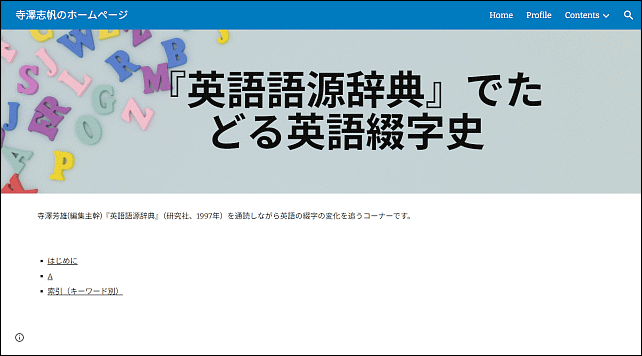
khelf の寺澤志帆さんの連載企画「『英語語源辞典』でたどる英語綴字史」が,11月1日に公開された記事「160. anemone ―発音は/ənéməni/―」をもって,開始から丸半年を迎えました(おめでとう!).筆者曰く,
今日で「『英語語源辞典』でたどる英語綴字史」連載から半年が経ちました。気の向くまま(時折休みつつ)地道に続けてきましたが、半年で進んだのはなんと44ページ目まで。1年経過したときにAで始まる語を読み終えているのか、それとも立ち止まりすぎてAからまだ抜け出せていないのか、どうぞ気長にお楽しみください。
いまだ A の項目から抜け出せていない旨が述べられていますが,すでに160を越える英単語語源エッセイが公開されており,連載として安定感が出てきました.英語史的には第一級のおもしろさです.英単語の語源,とりわけ綴字に関心のある方は必読です.定期購読のために RSS フィードも用意されています.
この連載が学術的な価値をもっているのは,信頼のおける『英語語源辞典』(研究社)が基盤にあるからということもありますが,研究者としての寺澤さんの学究的姿勢が現われているからです.常に OED をはじめとする各種の専門的な文献を参照し,「裏取り」をしたり,諸説を比較検討したりするのは,それ自体が学術活動です.
連載開始から1ヶ月ほど経った頃の「34. <c>か<cc>か、それが問題だ! (<acc->を持つ語について)」辺りからは,遊び心ある副題が付くようになっています.その単語に対する筆者の関心の在処がわかり,ぐんと読みやすくなっています.
最近の記事でとても勉強になったのは「158. and ―弱形an―」です.an = "(and) if" の中英語や近代英語からの用例が挙げられており,これは相当に注意を払っていないと読み落としたり読み違えたりする可能性が高いと思いました.記事末尾には「148. ampersand ―&の名前―」への参照もあり,A の項目内にとどまるとはいえ,このようなクロスレファレンスも充実してきています.
寺澤志帆さんの連載「『英語語源辞典』でたどる英語綴字史」については,過去にも hellog や heldio で触れてきました.ぜひこちらもご参照ください.
・ hellog 「#5861. khelf 寺澤志帆さんが「『英語語源辞典』でたどる英語綴字史」シリーズを開始しています」 ([2025-05-14-1])
・ heldio 「#1443. 「『英語語源辞典』でたどる英語綴字史」 by khelf 寺澤志帆さん」
・ heldio 「#1556. khelf 寺澤志帆さんの「『英語語源辞典』でたどる英語綴字史」が好調です --- RSS も用意されています」
・ 寺澤 芳雄(編集主幹) 『英語語源辞典』新装版 研究社,2024年.
2025-10-30 Thu
■ #6030. 「3文字規則」まとめ --- 短い単語に隠された正書法とアイデンティティの問題 [three-letter_rule][orthography][spelling][personal_name][onomastics][sociolinguistics]
本ブログでも何度か取り上げてきた「3文字規則」 (three-letter_rule) についてポイントをまとめます.もっとも基本となる記事は「#2235. 3文字規則」 ([2015-06-10-1])です.
英単語を眺めていると,ごく短い2文字からなるものがいくつかあることに気づきます.an, is, of などです.このような短い語は,いずれも文法的機を帯びた「機能語」 (function word) であり,具体的な意味をもつ名詞や動詞に代表される「内容語」 (content word) ではありません.英語には,機能語は2文字以下の短さが許されるけれども,内容語については必ず3文字以上で綴られなければならないという「3文字規則」 (three-letter_rule) なる珍妙なルールがあります.
繰り返しますが,「3文字規則」が適用されるのは,内容語についてのみです.機能語,すなわち代名詞,助動詞,前置詞,接続詞などに代表される文法機能を担う語で,典型的に頻度がきわめて高い語類については,この規則は適用されません.たとえば,電子メールなどで頻繁に使われる2文字の単語 re (= about) は,頻度が高いものの,機能語であるため「3文字規則」の例外とはみなされません.
では,なぜ内容語は3文字を下限とするのでしょうか.この規則は,単語機能の効率性という実用的な尺度が関わっていると考えられます.一般的に,よく読み書きする単語の綴字は短いほうが効率的です.日常的によく使うわけですから,出番が多く,語形としては短い方に越したことはありません.これは統計的に考えても合理的な方策と言えます.
もちろん「規則」には例外が付きものです.ax (斧), ox (雄牛)のような一般的な例外がすぐに挙がってきますが,ほかにも専門的な例外として Od (ドイツの科学者 K. von Reichenbach が1845年に創成した仮説上の物理学的力)もあります.その他のエキゾチックな語として aa, ai, ba, bo, bu など,ほとんど知られていない例外も挙げられますが,これらの見慣れない例外こそが,むしろ当該規則の一般性を裏付けているとも言えます.
「3文字規則」のパロディと言えるものに,人名に見られる「4文字規則」なるものがあります.人名の綴字には,通常の英単語の正書法に照らせば余分と見なされる文字が含まれることが,しばあります.Anne, Kidd, Locke, Smythe, Webb のような事例です.これは,人名がアイデンティティや存在感を示すための手段であり,視覚的に「盛る」傾向があるためと考えられます.
上記のように,英語の「3文字規則」は,内容語の綴字の下限を定める,実用的な正書法のルールと言えます,一方,人名においては,アイデンティティを強調し,視覚的な存在感を示すために,あえて綴字を長くする「4文字規則」のような副次的な慣習が存在します.
これら2つの規則は,英語の綴字が単なる音の記録ではなく,頻度,効率,視覚性,そして社会的アイデンティティといった多様な要因を組み込んだ記号であることを示唆しているのです.
2025-10-26 Sun
■ #6026. OED にみる1人称代名詞 I の異形 [personal_pronoun][spelling][variation][oed][dialect][punctuation][through][orthography]
本ブログでは,英語史における綴字の多様性について折に触れて取り上げてきた.特に「#53. 後期中英語期の through の綴りは515通り」 ([2009-06-20-1]),「#5738. 516番目の through を見つけました」 ([2025-01-11-1]) で取り上げた through の例は,現代の標準化された正書法に慣れた私たちにとって衝撃的ですらある.
さて,今回は through に勝るとも劣らないであろう,身近な単語の歴史的異形の多さをご紹介したい.1人称単数主格代名詞の I である.現代英語ではアルファベット1文字で表わされるこの代名詞が,歴史上,あるいは方言において,どれほど豊かな姿を見せてきたことか.OED の I (PRONOUN & NOUN2) の項目に掲載されている variant forms のセクションの1部を覗いてみることにしよう.
以下に,時代や地域を考慮せずに集められた I の異形を一覧で示す.その圧倒的な数に驚かれるかもしれない.
α.
(a)
ich (Northumbrian), ih (Northumbrian)
ig (rare)
ic
hic, icc
yc
Hic, Hit (transmission error), hyc, Ic, Icc, ick (northern), Iic, Ik (east midlands and northern), it (transmission error), yg
ik (chiefly east midlands and northern), ike (east midlands and northern), yk
(b) Scottish
ic, ik
β.
(a)
i
Hi, hi, Hy, ij, yi, yj
y
I
a (Yorkshire and Norfolk), e, hij, hy, j, Y
a (regional)
ah (regional), oi (regional)
(b) U.S. regional (chiefly south Midland and southern)
ah, uh
Ah, Hi, Oy, oy, u
(c) English regional
a (chiefly northern and north midlands)
ai (Devon), au (northern and north midlands), aye (Yorkshire), ee (northern), eh (Lancashire), eigh (Yorkshire), ha (Yorkshire), O (Yorkshire)
Aa (northern), aa (northern), Ah (northern and north midlands), ah (northern and north midlands), aw (northern and north midlands), hah (Yorkshire), Oi, oi
A (chiefly northern and north midlands), hi (Worcestershire)
(d) Scottish
i, y
a, I
Aw, aw
A, Aa, Ah, ah, Eh (Dundee), eh (Dundee), ey (Dundee)
(e) Also Irish English
a' (northern)
a (northern), Oi (southern), oi (southern)
A (northern), Ah (northern), ah (northern)
(f) Also Australian
Oi, O'i, oi
γ.
(a)
ich
ch (probably transmission error), Hich, hich, icche, ichc, ichs, icht, ics, Ih, ih, Ihc, ihc, ihic (probably transmission error), iho (transmission error), Iich, iich, yh
ych
Ich, jch, yche
iche
(b) English regional (south-western)
ich
iche (Somerset), ichy (Dorset), ish (Devon), uch, utch, utchy (Somerset)
(c) Irish English (Wexford)
ich
δ.
(a)
his, is
(b) English regional (south-western)
ees (Devon), es, Iss (Devon)
ise, us (Somerset)
Ice (Somerset), is (Cornwall), ize
ε. Chiefly English regional (south-western)
chee
che
しめて以下の98種類の綴字が得られた:A, a, a', Aa, aa, ah, Ah, ai, au, aw, Aw, aye, ch, che, chee, e, ee, ees, eh, Eh, eigh, es, ey, ha, hah, hi, Hi, Hic, hic, Hich, hich, hij, his, Hit, hy, Hy, hyc, i, I, ic, Ic, icc, Icc, icche, Ice, Ich, ich, ichc, iche, ichs, icht, ichy, ick, ics, ig, Ih, ih, Ihc, ihc, ihic, iho, Iic, Iich, iich, ij, ik, Ik, ike, is, ise, ish, Iss, it, ize, j, jch, O, O'i, Oi, oi, Oy, oy, u, uch, uh, us, utch, utchy, y, Y, yc, ych, yche, yg, yh, yi, yj, yk
なお,OED では,この一覧の直前に次の但し書きがついている."(Capitalization in Middle English examples frequently reflects the editorial choices of modern editors of texts, rather than the practice of the manuscripts.)"
写本における実際の大文字・小文字の使い分けまで考慮に入れれば,異形の数はさらに増えるだろう.先に触れた through の516通りには及ばないかもしれないが,それでも,たった1つの機能語が示してきた多様性に驚きを禁じ得ない.人称代名詞 (personal_pronoun) のような基本語ですら,いや基本語だからこそ,その歴史は豊かである.
2025-05-14 Wed
■ #5861. khelf 寺澤志帆さんが「『英語語源辞典』でたどる英語綴字史」シリーズを開始しています [khelf][kdee][helkatsu][spelling_pronunciation_gap][terasawashiho][etymological_spelling][spelling][orthography]

月曜日に Voicy 「英語の語源が身につくラジオ (heldio)」にて,khelf(慶應英語史フォーラム)の寺澤志帆さんと対談し,寺澤さんが最近始められた「『英語語源辞典』でたどる英語綴字史」という企画を紹介していただきました.今回の記事でも,その企画について改めてご案内します.
寺澤さんが始められたのは,私が日頃「世界一の英語語源辞典」として言及している推薦書・愛読書で,研究社より出版されている『英語語源辞典』 (kdee) を通読しながら,英語綴字史的に興味深い項目をコンテンツ化して紹介していくというシリーズです.寺澤さんご自身のHPで,ブログ記事のような形で発信されています.
これに似た企画,どこかで聞いたことがありますよね.そう,heldio/helwa のリスナー lacolaco さんが,に1年以上前から「英語語源辞典通読ノート」の企画を始めており,hel活 (helkatsu) 界隈では評判となっています.寺澤さんの企画は,その流れを汲んでの第2弾といえます.
lacolaco さんが総合的な観点からおもしろい語源の話題をピックアップされているのに対し,寺澤さんはご自身の専門である英語綴字史の観点に絞って興味深いトピックを拾い出しています.綴字と発音の乖離 (spelling_pronunciation_gap) は英語史の定番の話題です.その点で,寺澤さんの通読シリーズは英語史の中心的テーマに迫ろうとする試みとなります.
寺澤さんは5月1日からこの企画を開始しており,今後はご自身のペースで定期的に続けていくとのことです.私も過去にこの『英語語源辞典』を通読してみようと試みたことがあるのですが,最初のページで深掘りしすぎてしまい,これは無理だと早々に諦めました.あの分厚い辞典を最初から最後まで読み通すというのは,まさに無謀とも思える試みです.だからこそ,それを実際に始められている寺澤さんや lacolaco さんの熱意には脱帽します.
さて,具体的にどのような記事が公開されているのでしょうか.例えば,この間の金曜日には ab(h)ominable の項目が紹介されていました.この語は現代英語では abominable と綴られますが,かつては abhominable のような h が入った形も存在しました.『英語語源辞典』では,この h があるものとないものが別々の項目として立てられており,その歴史的な変遷が示されています.これはまさに寺澤さんが専門的に研究している語源的綴字 (etymological_spelling) の話題です.寺澤さんは,『英語語源辞典』の記述をベースにしつつ,必要に応じて OED なども参照しながら,深掘り解説を加えています.
『英語語源辞典』を通読し,それをウェブ上で公開するというユニークな取り組みは,lacolaco さんに続き寺澤さんも始められたことで,ちょっとしたブーム(?)になりつつありますね.一般的に辞書は引くものであって通読するものではないと考えられていると思いますので,出版元の研究社さんも驚かれているのではないでしょうか.
本ブログ読者の皆さんも,ぜひ寺澤さんによる新企画「『英語語源辞典』でたどる英語綴字史」を末永く応援していただけますと幸いです.この企画を開始したきっかけの話題を含めた,寺澤さんとの heldio 対談について,「#1443. 「『英語語源辞典』でたどる英語綴字史」 by khelf 寺澤志帆さん」よりお聴きください.
・ 寺澤 芳雄(編集主幹) 『英語語源辞典』新装版 研究社,2024年.
2025-04-28 Mon
■ #5845. 『ことばと文字』特集「語彙と文字の近代化 --- 対照言語史の視点から」の各論考の概要をご紹介 [contrastive_language_history][review][heldio][lexicography][orthography]
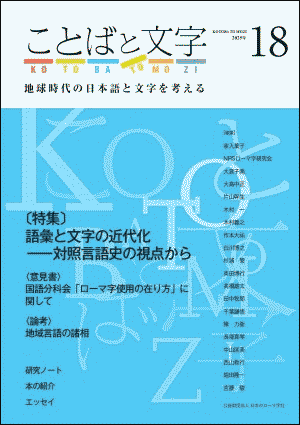
3週間前に一度「#5824. 近刊『ことばと文字』18号の特集「語彙と文字の近代化 --- 対照言語史の視点から」」 ([2025-04-07-1]) の記事を公開しました.この特集企画を掲載した『ことばと文字』18号が,先日4月25日に発売となりましたので,このタイミングであらためて特集企画をご紹介したいと思います.
特集のタイトルは「対照言語史から見た語彙と文字の近代化」です.日本語史の田中牧郎氏(明治大学),ドイツ語史の高田博行氏(学習院大学),英語史の堀田隆一(慶應義塾大学)が中心となり、日本語・中国語・英語・ドイツ語・フランス語の5言語(史)の専門家とともに進めてきた企画が,今回実現した次第です.
特集では,各言語史の専門家がそれぞれの言語における語彙と文字の近代化について論じており,さらに一部の論文(以下で★印のついているもの)には他の言語史の研究者からのコメントが付され,言語間の対照がより深くなされています.以下,序論にまとめられている各論文の概要を,さらに要約してご紹介します.
【 日本語史・中国語史 】
・ 田中牧郎 ★「日本語の語彙と文字・表記の近代化」
19世紀後半の西洋語翻訳を機に,新メディアの表現者たちの工夫で語彙が近代化し,啓蒙家や国家主導の言語改革で文字・表記が近代化されたことをコーパスで実証しています.
・ 木村一 「西洋言語との接触による文字の近代化」
16世紀にキリシタンがもたらしたローマ字は音節をより細分化して示す点で画期的でしたが,日本語の文字史に加わった過程とその意義を考察しています.
・ 高橋雄太 「近代語の表記の変遷からみる「当用漢字表」」
近代化に伴う教育普及の課題に対し,初めて実効性を持った漢字政策「当用漢字表」(1946年)がどう設計されたかを解説しています.
・ 陳力衛 「日本語における漢語語彙の近代化」
明治初期に急増した漢語について,「早見漢語便覧」を例に形態・意味から検証し,淘汰と定着の要因を探り,近代化プロセスを考察しています.
・ 千葉謙悟 ★「中国語における語彙と漢字の近代化 --- 北京語の革新と鋳造活字の誕生」
北京語彙に官話語彙や新漢語を取り込んで語彙が近代化し,それを支えた活字創製と印刷書体確立の過程を跡づけています.
【 英語史・ドイツ語史・フランス語史 】
・ 堀田隆一 ★「英語語彙の近代化 --- 英語史におけるギリシア借用語」
英語語彙におけるギリシア語の存在感を歴史的に論じ,15世紀以降の借用,18世紀以降の科学技術発展における新語形成が近代化・国際化に果たした役割を指摘しています.
・ 家入葉子 「15世紀英語の綴り字のバリエーションとその収束 --- Pepys 2125 写本の事例から綴り字研究の課題を考える」
特定写本から15世紀英語の綴り字変異を調査し,音韻変化だけでなく政治社会の変化や分布も考慮すべきことを論じています.
・ 中山匡美 「後期近代英語期の綴り字改革 --- 挫折と成功」
18--20世紀の綴り字改革が英米で異なる動機で試みられたこと,その抜本改革は失敗したものの Webster の一部修正綴りは定着したことなどの経緯を記述しています.
・ 高田博行 ★「ドイツ語の語彙と綴字法の近代化」
17世紀に注目された形態論的原理が,綴字法の近代化と語彙形成の両方で参照され,専門術語形成や語彙の自国語化を促したことを指摘しています.
・ 大倉子南 「ドイツ語史における文字の近代化 --- イデオロギー化された文字」
フラクトゥーア書体とアンティカ書体の使用をめぐる論争から近代化が始まり,イデオロギーにより前者が長く保持された歴史を跡づけています.
・ 西山教行 ★「フランス語の近代化における辞書の貢献」
アカデミー・フランセーズ辞書,特にフランス革命期の第5版がフランス語の近代化に果たした役割を分析し,人為的な近代化と新語の盛衰を指摘しています.
・ 片山幹生 「豊穣なる混沌 --- ルネサンス期のフランス語における語彙の拡張」
16世紀フランス語語彙の画期的な発展に注目し,ラテン語・イタリア語からの借用が主因だったこと,また世紀後半には独自の洗練を目指す意識の高まったことを論じています.
各言語が「近代」という時代にどのように向き合い,語彙とそれを書き留める手段である文字を整備していったのか.その道筋は言語ごとに多様でありながらも,他言語からの影響,国家や知識人の役割,規範意識,技術革新といった共通のテーマも見え隠れします.本特集を通じて,読者の方々がご自身の関心のある言語史と比較しながら,他の言語の歴史にも目を向けるきっかけとなれば幸いです.コメント付き論文はもちろん,ぜひ各論文を読み比べて,知的刺激に満ちた対照言語史の世界に浸っていただければ.
・ 田中 牧郎・高田 博行・堀田 隆一(編) 特集「語彙と文字の近代化 --- 対照言語史の視点から」『ことばと文字18号:地球時代の日本語と文字を考える』(日本のローマ字社(編)) くろしお出版,2024年4月25日.4--136頁.
2025-03-25 Tue
■ #5811. なぜ wind は短母音を示すのか? (3) [sobokunagimon][vowel][gvs][emode][variation][emode][orthoepy][orthography][variation]
標記の問題について,「#5808. なぜ wind は短母音を示すのか?」 ([2025-03-22-1]) と「#5810. なぜ wind は短母音を示すのか? (2)」 ([2025-03-24-1]) で考えてきた.前者の記事で引いた OED の説明書きで Dobson が言及されていたので,そちらに当たってみた.Dobson (Vol. 2, §12) は,初期近代英語期における前舌高母音の長短の変異について,wind や関連する単語の事例を挙げながら論じている.議論の一部を引用しよう.
The variation occurs chiefly before OE lengthening groups. The most important class of word is those in -ind, which are normally recorded with ME ī; but there is some evidence of variation. Smith gives 'uīnd or uind' for wind sb. Mulcaster has ĭ in wind and bind against ī in kind, find, mind, and hind. Bullokar transcribes find with ī but rhymes it on ĭ. Coote says that some pronounce blind, find, and behind short, while others pronounce them long; Young's 'homophone' list shows variation in find. Hodges says that 'som men cal the winde, the wind'. It is clear that the variation was most common in wind, which has now come to have the short vowel; but in the sexteenth and seventeenth centuries it was more usually pronounced with ME ī given by Levins, Bullokar, Robinson, Gil, Willis, Wharton, Poole, J. Smith, Cooper, and Brown. Short ĭ (due to the separation of the n and d by the syllable-division) is apparently shown for winder by Fox and Hookes, who put it with window in their homophone list; but Bullokar has ī. (479)
16--17世紀における -ind 語には,母音の長短の揺れがあったことがわかる.とりわけ問題の wind については揺れが激しかったようだ.個々の話者によっても,また時代や使用域によっても,揺れがあったにちがいない.当時の両発音の複雑な競合が,現代標準英語では「不規則」に思われる短母音に帰結してしまったということで,言語変異・変化の不思議さを思わずにはいられない.
・ Dobson, E. J. English Pronunciation 1500--1700. 2nd ed. 2 vols. Oxford: OUP, 1968.
2025-02-20 Thu
■ #5778. connection か connexion か? [x][webster][latin][french][spelling][orthography][ame_bre][voicy][heldio]
5日ほど前に Voicy heldio にて,リスナー lacolaco さんの「英語語源辞典通読ノート」の最新回に基づいて「#1357. 接頭辞 con- の単語はまだ続く --- lacolaco さんの「英語語源辞典通読ノート」最新回より」と題する音声配信をお届けした.
そこで話題の1つとして,「コネクション」に対応する英単語の綴字が connection と connexion の間で揺れを示す件が触れられた.前者の綴字が一般的だがイギリス式では後者の綴字も見られるという.deflection, inflection, reflection についても同様に,メジャーな <-ction> に対してマイナーな <-xion> も辞書に登録されている.一方,complexion については,むしろこちらの綴字のほうが一般的で complection は稀である.
上記の heldio の配信後,この問題に関心を抱かれたリスナーのり~みんさんが,「-ction v.s. -xion」と題して Google Ngram での調査と合わせて記事を書かれている.
私もこの問題が気になって,少し調べてみた.というのも,私自身の研究テーマが英語の屈折 (inflection) の歴史にあり,先行研究の文献内で inflexion の綴字をよく目にしてきたからだ.
Upward and Davidson (167--68) によれば,英語では本来的には <-xion> も普通に見られたが,アメリカの辞書編纂家かつ綴字改革者の Noah Webster (1758--1843) が <-ction> のほうを推奨したのだという.19世紀から現代にかけての <-ction> の一般化に,Webster の影響があったらしい.
-XION and -CTION
Complexion, crucifixion, fluxion are standard ModE forms, and connexion, deflexion, inflexion exist as alternatives to connection, etc.
・ Complexion derives from the past participle plexum from the Lat verb plectere; although ME and EModE used such alternatives as complection, complection, ModE is firm on the x-spelling.
・ Crucifixion derives from the participle fixum of figere 'to fix'; the form crucifixion has been consistently used in the Christian tradition, and *crucifiction is not attested.
・ Fluxion is similarly determined by the Lat participle fluxum; the verb fluere offers no -CT- alternative.
・ Uncertainty has arisen in the case of connexion, deflexion, inflexion because, despite the Lat participles nexum, flexum with x, the corresponding infinitives, nectere, flectere have given rise to the Eng verbs connect, deflect, inflect.
・ In his American Dictionary of the English Language (1828), the American lexicographer Noah Webster . . . recommended the -CT- forms, which (despite ModFr connexion, deflexion, inflexion are today found much more frequently.
単純化していえば <-xion> はラテン語の過去分詞に基づき,かつそれを採用したフランス語的な綴字であり,<-ction> はラテン語の不定詞に基づき,それを推奨したアメリカ英語的な綴字ということになる.crucifixion が <-xion> としか綴られないのは,十字架の表象たる <X> と関係があるのだろうか,謎である.
今回の問題と関連して「#2280. <x> の話」 ([2015-07-25-1]) も参照.
・ Upward, Christopher and George Davidson. The History of English Spelling. Malden, MA: Wiley-Blackwell, 2011.
2024-12-28 Sat
■ #5724. 英語綴字におけるフランス語の影響 --- 月刊『ふらんす』の連載記事第10弾 [hakusuisha][french][rensai][furansu_rensai][contact][spelling][orthography][diacritical_mark][h][consonant][hypercorrection][heldio]
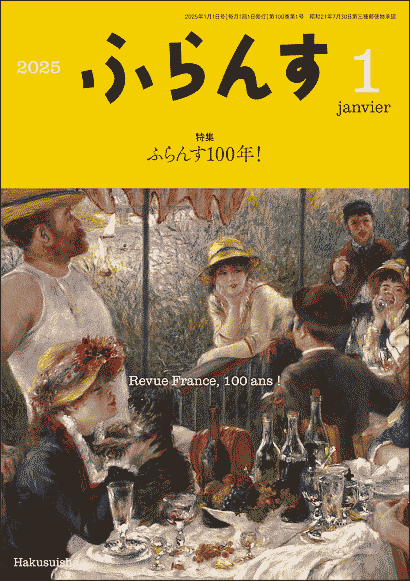
*
12月23日,白水社の月刊誌『ふらんす』2025年1月号が刊行されました.今年度,同誌で連載記事「英語史で眺めるフランス語」を寄稿していますが,今回は第10回「英語綴字におけるフランス語の影響」です.
なんと今号は『ふらんす』の100周年号という記念すべき号でした."Revue France, 100 ans!" と表紙にあり,特集企画「ふらんす100年!」も掲載されています.そのような記念号の一画に,フランス語史ならぬ英語史の連載記事を載せていただくのは恐縮でもあり,喜びでもあります.稀な瞬間に立ち会わせていただき,白水社さんにも感謝いたします.
1. 英語の綴字は意外とフランス語風
ノルマン征服の影響で,その後の英語の綴字にはフランス語の綴字習慣が多分に反映されています.英単語の綴字が実はフランス語的であることはあまり知られていません.
2. 「氷」が īs から ice へ
英語の綴字は,フランス語の影響のもと中英語期にかけて大きく変容しました.「過剰修正」の結果,例えば現代英語の ice にみられるような -ce の綴字が広く採用されました.
3. チャ行子音の綴字が c から ch へ
フランス語の影響により,古英語では c で表記されたチャ行子音が中英語期に ch へと置換されました.これにより英単語 child や church などの綴字が確立しました.
4. 消えた古英語の文字
古英語で常用された文字 (æ, ƿ, þ, ð)は,フランス語に存在しなかったこともあり,中英語以降に衰退していき,最終的には消滅しました.
5. なぜ英語綴字はフランス語かぶれしたのか?
英語綴字は,簡素化や合理化の方向を目指すのではなく,むしろ威信あるフランス語の綴字習慣を受け入れることにより,若干複雑化しました.フランス語は権力と教養と洗練の言語だったのです.
英語の綴字におけるフランス語の影響は,中英語期の綴字変化や古英語文字の廃用に顕著に見られます.これにより古英語的な綴字は影を潜め,代わって現代的な見栄えの綴字が拡がることになりました.
さらに詳しくは,直接『ふらんす』1月号を手に取ってお読みいただければ.過去9回の連載記事は hellog 記事群 furansu_rensai で紹介してきましたので,そちらもご参照ください.
今号と関連して,heldio でも「#1305. 英語綴字におけるフランス語の影響 --- 月刊『ふらんす』の連載記事第10弾」と題してお話ししていますので,こちらもお聴きください.
・ 堀田 隆一 「英語史で眺めるフランス語 第10回 英語綴字におけるフランス語の影響」『ふらんす』2025年1月号,白水社,2024年12月23日.52--53頁.
2024-12-12 Thu
■ #5708. 2重字 <gh> の起源 --- <ch>, <sh>, <th>, <wh> と考え合わせて [grapheme][graphotactics][orthography][spelling][gh][digraph][h][consonant][silent_letter][diacritical_mark][grapheme][yogh]
昨日の記事「#5707. 2重字 <gh> の起源」 ([2024-12-11-1]) に続き,<gh> がいかにして出現したかについて.英語綴字史の古典を著わした Scragg (46--47) に,次のくだりがある.
The use of <h> as a diacritic in <ch> and <sh>, indicating that <c> and <s> have a pronunciation different from that normally expected of those consonantsa, was not new to English when <ch> was introduced from French, for <th> had earlier been used alongside <þ> (cf. footnotes to pp. 2b and 17). Both <ch> in French and <th> in English derive from Latin orthography, use of <h> as a diacritic in Latin being made possible by the disappearance of the sounds represented by <h> from the language in the late classical period. As a result of the establishment in English of diacritic <h> in <ch> and <th>, other consonant groups were formed on the same pattern. The grapheme <gh> has already been discussed (p. 23c). <wh> has a rather different history, for it began in Old English as an initial consonantal combination <hw> corresponding to /xw/. Assimilation of the group to a single voiceless consonant /ʍ/ had taken place by the late Old English period, and Middle English scribes, associating the sequence <hw> for the single phoneme with the use of <h> as a fricative marker in other graphemes, reversed the graphs to <wh>.
English scribes' incorporation into their spelling system of the grapheme <ch>, and the 'consequential' changes which resulted in the creation of <sh> and <wh>, were made possible by their knowledge of Anglo-Norman conventions.
この引用文のなかに同著内への参照が何カ所があるが,そちらを参照すると重要な記述がみつかったので,引用者による注記符号に対応させるかたちで以下に参照先の解説文を掲載する.
a I.e. <h> as a fricative marker, allowing for the fact that <sh> is historically a simplification of <sch>. (fn. 2 to p. 46)
b Latin <th> had always been recognised as an alternative to thorn by English writers; even before the Norman Conquest, foreign names were spelt with either: Elizabeth or Elizabeþ, Thomas or þomas. (fn. 2 to p. 2)
c <ȝ> was also used in Middle English for the two allophones of /j/ which occurred after a vowel: [ç] and [x]. These two sounds gave scribes considerable difficulty in Middle English; among the many graphemes representing them are the Anglo-Norman <s>, the Old English <h>, the new grapheme <ȝ>, and the last two combined as <ȝh>. In the fifteenth century, when the distinction between <ȝ> and <g> became blurred, this combination was written <gh>, and this is the sequence which has survived in a great many words in which [ç] and [x] were once heard, or still are in northern dialects, e.g. high, ought, night, bough. (fn. 2 to p. 23)
以上より,今回の話題に関連する重要な点を箇条書きすると,次の通り.
(1) <th> は古英語期にも用いられることがあった
(2) 2重字 <ch> と <th> はおおもとはラテン語正書法に由来する
(3) <h> が発音区別符(号) (diacritical_mark) として用いられるようになったのは,古典期後のラテン語で h が無音化し,<h> が解放されたから
(4) 2文字目に <h> をもつ既存の2重字のパターンが,アングロノルマン語の綴字慣習を知っていた英語写字生の手により,他へも拡大した
(5) 2文字目に <h> をもつ2重字は,(h が本来的に摩擦音なので)摩擦音を示す
<gh> を含む2重字の起源と発達が徐々に見えてきた.
・ Scragg, D. G. A History of English Spelling. Manchester: Manchester UP, 1974.
2024-12-11 Wed
■ #5707. 2重字 <gh> の起源 [graphotactics][orthography][spelling][gh][digraph][h][anglo-norman][scribe][yogh][consonant][silent_letter][diacritical_mark][grapheme][yogh]
2重字 (digraph) の <gh> については,本ブログでも gh の各記事で話題にしてきた.この2重字 <gh> については,それが表わす音価とともに,英語史上でもいろいろな論点がある.そのなかでも注目したい問題の1つに起源の問題がある.古英語では,中英語以降に典型的に <gh> が用いられる多くのケースで,<h> の1文字が使われていた.中英語になると,この環境における <h> の使用は徐々に衰退していき,代わって <gh> や <ȝ> (= yogh) が台頭してくることになる.<gh> はいったいどこから来たのだろうか.
Upward and Davidson (182) によると,2重語 <gh> はアングロノルマン写字生によってもたらされた新機軸であるという.
. . . ANorm scribes frequently replaced the OE H with GH: OE niht, ME night; OE brohte, ME broughte 'brought'. (The letter ȝ was also used: niȝt, brouȝte.) The GH represented /x/, which was pronounced [ç] after a front vowel and [x] after a back vowel, as in ME night and broughte respectively (and as also in Modern German). Although, under the influence of Chancery and the printers, this digraph has continued to be written from the ME period to the present day, the sound it represented/represents has undergone many changes.
アングロノルマン語の綴字には <ch>, <sh>, <th>, <wh> など2文字目に <h> をもつ2重字の使用が確認される.これらすべてが現代英語で見慣れているほど多く用いられていたわけではないものの,2重字 <gh> もこれらの仲間だった (cf.Anglo-Norman Dictionary) .アングロノルマン語を書き慣れた写字生や,その影響を受けた英語の写字生が,英語を書く際にも <gh> を持ち込んだということになる.
・ Upward, Christopher and George Davidson. The History of English Spelling. Malden, MA: Wiley-Blackwell, 2011.
2024-11-15 Fri
■ #5681. 山口美知代先生との3回の heldio 対談 [voicy][heldio][notice][world_englishes][we_nyumon][caribbean][variety][jamaica][creole][review][spelling_reform][orthography]
去る10月,山口美知代先生(京都府立大学)と Voicy heldio で3度にわたり対談させていただきました.
最初の2回は,昨年昭和堂より出版された『World Englishes 入門』の共著者のお一人として世界英語 (world_englishes) について,とりわけ「カリブ海の英語」と「中華世界の英語」について,お話しを賜わりました.
・ 「#1231. 著者と語る『World Englishes 入門』(昭和堂,2023年) --- 山口美知代先生とのカリブ海の英語をめぐる対談」(2024年10月12日配信)
・ 「#1235. 著者と語る『World Englishes 入門』(昭和堂,2023年) --- 山口美知代先生との中華世界の英語をめぐる対談」(2024年10月16日配信)
「カリブ海の英語」は,おそらく多くの方々にとってあまり馴染みのない変種と思われますが,それだけに英語の世界の奥深さが伝わるはずです.一方,「中華世界の英語」はずっと身近な気はするものの,具体的には知らないことが意外と多いのではないでしょうか.
2回の対談を通じて,世界の隅々で英語が用いられていることが再確認できたと思います.ぜひ,これまでの『World Englishes 入門』関連の hellog 記事や heldio 対談回へ,we_nymon を通じてアクセスしていただければ.
さて,山口先生との第3回目の対談回では,今年開拓社より出版されました単著『ハリウッド映画と英語の変化』について,著者直々にご紹介いただきました.「#1241. 著者と語る『ハリウッド映画と英語の変化』(開拓社,2024年) --- 山口美知代先生との対談」(2024年10月22日配信)をお聴きください.
『ハリウッド映画と英語の変化』については,今年の4月11日の heldio にて私単独で「#1046. 山口美知代『ハリウッド映画と英語の変化』(開拓社,2024年)」としても紹介していますので,そちらもお聴きください.hellog 記事としては「#5469. 山口美知代『ハリウッド映画と英語の変化』(開拓社,2024年)」 ([2024-04-17-1]) をどうぞ.
山口先生,お忙しいところ,対談のお時間を割いていただきまして,ありがとうございました!
・ 大石 晴美(編) 『World Englishes 入門』 昭和堂,2023年.
・ 山口 美知代 『ハリウッド映画と英語の変化』 開拓社,2024年.
2024-10-14 Mon
■ #5649. いつ <l> の綴字を重ねるか? [spelling][orthography][latin][greek][french][prefix][etymology][l]
昨日の記事「#5648. <l> の綴字を重ねるか否かの問題」 ([2024-10-13-1]) に続き,<ll> の話題.今回はイギリス英語では <ll> と重ね,アメリカ英語では <l> と1つのみ,という既知の傾向は別として,どのような単語において <ll> が現われるか,その分布をみてみたい.
昨日,次のように述べた.
<ll> はもともと古典語にゆかりのある綴字だったが,そこへ非古典語であるフランス語が混乱要因として参入してきた.フランス語は古典語由来の重ねた <ll> をそのまま受け継がず,1重化した <l> で継承することがしばしばあったために,それらが混在している英語語彙は正書法上 <l> を重ねるか否かについての厄介な問題を抱え込むことになったのだ.
<ll> の分布について,Carney (250) の説明と単語例の列挙を引用しよう.
Normally, <l> would double after a short vowel in a monosyllable (bell, cell, doll, mill, etc.), but there are some exceptions. There are all marginal in various ways, usually by abbreviation: technical loan col ('gap between hills' < French); gal (< girl), pal (< Romany); technical abbreviations bet (< the name '(A. G.) Bell', = 'unit of power comparison'), cel (< celluloid . . .), gel (< gelatine), mel ('perpetual unit of pitch'), mil (< millimetre), nil (contraction of Latin nihil); short names Hal (< Henry), Sal (< Sally) . . . .
Examples of <-ll-> with prefixes . . .:
- (reduced vowel): alleviate, alliteration, allude, allusion, ally (v.); collate, collateral, collect (v.), collide, collision.
- (unreduced vowel): Allocate, ally (n.); collect (n.), colleague, college, collimate, colloquy; illegal, illegible, illicit, illimitable, illuminate, illusion, illustrate; pellucid.
There are quite a few words which resemble the above and in which the <-ll-> is not covered by other doubling conventions: allegory, allergy, alligator. There is some etymological uncertainty about allot, allow, and allure. Allay has come to have a §Latinate appearance in spite of its Old English origin (a + lecgan). To the average reader these spellings must seem to belong with the §Latinate prefixes.
A good many words . . . have <-ll-> in the third syllable from the end of a free-form after a stressed short vowel. The ending <-ion> seems to require this spelling, but not in all instances: billion, bullion, galleon, million, mullion, pillion, postillion, stallion, but also battalion, pavilion, verlion. Compare doubled and single <r> in carrion--clarion.
Other examples of <-ll-> unaccounted for are: ballerina, ballistic, balloon, bellicose, brilliant, bulletin, calligraphy, calliopsis, camellia, colliery, ebullient, ellipse, embellish, fallacious, fallacy, fallible, gallery, gallium, halleluja, hallucinate, hellebore, intellect, intelligent, mellifluous, miscellany, palliate, pallium, parallel, pollute, shallot, shillelagh, tellurium.
Pseudo-compounds are: ballyhoo, bulldozer, hullaballoo, lollipop, scallywag.
<ll> をめぐる少々の傾向と諸々の混沌がつかめるのではないか.英語の正書法はかくも複雑である.
・ Carney, Edward. A Survey of English Spelling. Abingdon: Routledge, 1994.
2024-10-13 Sun
■ #5648. <l> の綴字を重ねるか否かの問題 [spelling][orthography][ame_bre][latin][greek][french][l]
英語の正書法では,<l> を重ねるかどうかが問題となるケースが少なからずある.
まず思い浮かぶのは traveler か traveller かの違いである.「#240. 綴字の英米差は大きいか小さいか?」 ([2009-12-23-1]) でみたように,典型的にアメリカ綴字では <l> は1つにとどまるが,イギリス綴字では <l> を重ねるのが規則である.しかし,そうかと思えば,アメリカ綴字の fulfill はむしろ <l> を重ね,イギリス綴字の fulfil は重ねないので,気が狂いそうになる.
<l> を重ねるか否かの綴字のヴァリエーションは古英語期よりあるといえばあり,問題としては歴史も深いし根も深いといってよいだろう.綴字として <l> が1つでも2つでも,結果として周囲の発音には影響を与えないので,役割不明であるという点においてたちが悪い.
私自身は,重ねた <ll> の綴字の本質は,直前の母音が「歴史的に」短母音であることを積極的に示すことにあると考えているが,現実にはそれほどたやすく片付けられる話題ではなさそうだ.現代英語の正書法を精査した Carney (250) は,"Distribution of <ll>" と題する1節にて,この問題を論じている.その節の冒頭部分を引用する.
There is more difficulty in accounting for the occurrence of double <-ll-> than for the double spelling of any other consonant. This is partly due to the frequency of <-ll-> in Latin and Greek stems and partly because §Latinate words borrowed by way of French may no longer have recognizable constituents.
<ll> はもともと古典語にゆかりのある綴字だったが,そこへ非古典語であるフランス語が混乱要因として参入してきた.フランス語は古典語由来の重ねた <ll> をそのまま受け継がず,1重化した <l> で継承することがしばしばあったために,それらが混在している英語語彙は正書法上 <l> を重ねるか否かについての厄介な問題を抱え込むことになったのだ.なるほど,英語らしいといえば英語らしい結果といってよい.残念でもありながら面白くもある.
ただし,現代英語の正書法の原則としていうならば,おおよそ次の規則が成立するのも確かである (Carney 251fn) .
In the Hanna (1966) spelling rules, <l> is the default spelling and:
1 <ll> word-final accented after /ɔː/ or a short vowel (tall, mill, bell, pull, hull).
<ll> の話題については,Voicy heldio で取り上げたことがある.「#456. -l なのか -ll なのか問題 ー till/until, travel(l)er, distil(l)」をお聴きいただければ.
・ Carney, Edward. A Survey of English Spelling. Abingdon: Routledge, 1994.
2024-07-13 Sat
■ #5556. kh の綴字をもつ単語とその外来性 [spelling][loan_word][digraph][h][digraph][silent_letter][orthography]
昨日の記事「#5555. kh の綴字」 ([2024-07-12-1]) に引き続き,2重字 (digraph) の <kh> について.Upward and Davidson (257) にまとまった記述があるので引用する.
KH
The KH spelling reflects an aspirated consonant (somewhat like [k] + [h]) or a fricative (like [x] as in Scottish loch) in the source or carrier languages, all from the Middle East or Indian subcontinent. In English, there is no difference in pronunciation between KH and K.
・ In initial position: khaki (< Hindi); khamsin 'hot wind' (< Arabic); khan (spelt caan when first borrowed in the 15th century; < a Turkic language)
- Khazi, a slang word for 'toilet' dating from the 19th century, is not, despite its spelling, of eastern origin, but probably derives from Italian or Spanish casa 'house'. It has various spellings in English (kazi, kharzie, karsey, etc.).
・ In medial position: astrakhan 'fabric' (< Russian place-name); bakhshish 'tip or bribe' (a spelling baksheesh --- see under 'K'); burkha (a spelling of burka/burqa --- see under 'K'); gymkhana (< Urdu gend-khana, altered by influence of gymnastics); kolkhoz 'collective farm in USSR' (< Russian).
・ In final position: ankh 'emblem of life' (< Egyptian 'nh); lakh '100,000' (also lac; < Hindi and Hindustani); rukh 'mythical bird' (another spelling of roc, which is the more common spelling in English; < Arabic rokh, rukhkh, Persian rukh); sheikh (< Arabic shaikh).
ほぼすべての単語が中東,インドア大陸,ロシアの諸言語に由来し,その原語の風味を保持するために,本来的には英語に馴染みのない <kh> という綴字が用いられているのだろう.書き言葉の綴字には,話し言葉の発音では標示し得ない,単語の由来を示唆する機能が部分的であれ備わっているという点が重要である.
・ Upward, Christopher and George Davidson. The History of English Spelling. Malden, MA: Wiley-Blackwell, 2011.
2024-07-12 Fri
■ #5555. kh の綴字 [spelling][loan_word][digraph][h][khelf][acronym][digraph][silent_letter][orthography]

khelf(慶應英語史フォーラム)では『英語史新聞』を発行するなど,英語史を振興する「hel活」 (helkatsu) を様々に展開しています.
khelf という呼称は "Keio History of the English Language Forum" の頭字語 (acronym) で,私自身の造語なのですが,日本語発音では「ケルフ」,英語発音では /kɛlf/ となるのだろうと思います.khelf の <kh> の綴字連続が見慣れないという声が寄せられましたので,英語の綴字における 2重字 (digraph) について本記事で取り上げます.
<kh> は,英語においては決して頻度の高い文字の組み合わせではありませんが,khaki (カーキ色),khan (カーン,ハーン,汗),Khmer (クメール人),Khoisan (コイサン語族),Sikh (シク教徒)などに見られ,いずれの単語でも <kh> ≡ /k/ の対応関係を示します.ただし,すべて借用語や固有名であり,英語正書法に完全に同化しているかといえば怪しいところです.Carney (221) では,<kh> に言及しつつ astrakhan (アストラカン織), gymkhana (野外競技会), khaki, khan, khedive (エジプト副王)が挙げられています.
Carney (328) では,<h> を2文字目としてもつ,子音を表わす他の2重字とともに <kh> が扱われています.関連箇所を引用しましょう.
The clusters <ch>, <ph>, <sh>, <th>, <wh>, are treated as spelling units. So are the clusters <gh>, <kh>, <rh>, but there is a difference. In the first group, the <h> has the natural function of indicating the features 'voiceless and fricative' in representing [ʧ], [f], [ʃ], [ʍ]; <th> represents only 'fricative' for both voiceless [θ] and voiced [ð]. In the group <gh>, <kh>, <rh>, the <h> is empty and arbitrary; there is some marking, however: <rh> is §Greek, <kh> is exotic.
<kh> の <h> は音声的には動機づけのない黙字 (silent_letter) といってしかるべきだが,最後に触れられているとおり,その単語が "exotic" であることを標示する機能は有しているようだ.khelf もユニークで魅惑的という意味での "exotic" な活動を目指したい.
・ Carney, Edward. A Survey of English Spelling. Abingdon: Routledge, 1994.
2024-07-08 Mon
■ #5551. 英語綴字に関心があるなら,まず Cook の The English Writing System (2004) を [review][spelling][pronunciation][spelling_pronunciation_gap][writing][orthography][punctuation][toc][typography]
本ブログでは英語の綴字と発音の乖離 (spelling_pronunciation_gap) の話題を多く取り上げてきた.私の専門領域の1つだからということもあるが,とりわけ日本の英語学習者が関心を抱きやすいトピックだということを経験上知っているからでもある.
英語の綴字とその歴史をめぐっては,さまざまな研究書や一般書が出版されてきた.最近の目立ったところでは Horobin, Simon. Does Spelling Matter? Oxford: OUP, 2013. があり,これは『スペリングの英語史』(早川書房,2017年)として私自身が翻訳書として出版してきた経緯もある.
今回は,読みやすい英書として本ブログでも何度も引用・参照してきた Vivian Cook による The English Writing System (Hodder Education, 2004) を紹介したい.書き言葉全般の話題から説き起こし,英語の綴字と正書法,その歴史,句読法,そして綴字学習にも話題が及ぶ.例示,課題,規則表,キーワード,参考文献,索引が完備されており,読み手に優しい.以下に目次を示す.
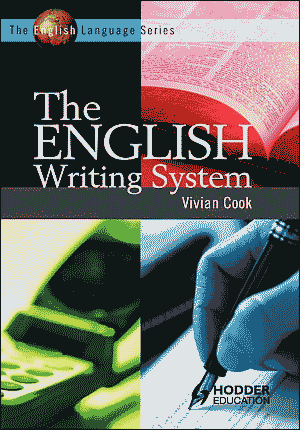
1 Ways of writing
1.1 Meaning-based and sound-based writing
1.2 Two ways of processing written language
2 The multi-dimensions of spoken and written English
2.1 Differences between the visual and acoustic media
2.2 Special features of written English
3 Approaches to English spelling
3.1 Basic rules for English
3.2 Venezky: correspondence rules and markers
3.3 Albrow: three systems of English spelling
3.4 Noam and Carol Chomsky: lexical representation
4 Punctuation and typography
4.1 Grammatical and correspondence punctuation
4.2 The typography of English
5 Learning the English writing system
5.1 English-speaking children's acquisition of spelling
5.2 Acquisition of English spelling by speakers of other languages
6 Historical changes
6.1 Before English
6.2 Old English
6.3 Middle English
6.4 From Early Modern English to Modern English
7 Variation in the English writing system
7.1 Differences of region: 'British' and 'American' spelling styles
7.2 Novel spellings of pop groups and business names
7.3 Adapting English to modern means of communication
References
IPA transcription of English phonemes
Index
英語綴字の見方が変わる本です.
・ Cook, Vivian. The English Writing System. London: Hodder Education, 2004.
・ Horobin, Simon. Does Spelling Matter? Oxford: OUP, 2013.
・ サイモン・ホロビン(著),堀田 隆一(訳) 『スペリングの英語史』 早川書房,2017年.
2024-06-18 Tue
■ #5531. Chancery English とは何か? [chancery_standard][standardisation][lme][spelling][orthography][signet]
現代標準英語の歴史的基盤はどこにあるか.この問題は英語史でも第一級の重要課題である.正書法に関する限り,それは中英語後期の Chancer English に求められる,とするのが Samuels (1963) 以来の有力な説である,これについては「#306. Samuels の中英語後期に発達した書きことば標準の4タイプ」 ([2010-02-27-1]),「#1228. 英語史における標準英語の発展と確立を巡って」 ([2012-09-06-1]))や「#3214. 1410年代から30年代にかけての Chancery English の萌芽」 ([2018-02-13-1]) をはじめとする chancery_standard の記事を参照されたい.
この Chancery とは「大法官庁」のことで,いわゆる国家の官僚組織を指す.では,その名前にあやかって後に Chancer English や Chancery Standard と呼ばれることになった英語変種とは,具体的には何のことなのだろうか.Fisher et al. (xii) より,当面の定義を与えておこう.
We follow M. L. Samuels, in calling the official written English of the first half of the 15th century "Chancery English" although it emanated from at least four offices, Signet, Privy Seal, Parliament, and the emerging Court of Chancery itself. The generalized term is valid in an historical sense. By the end of the 15th century the term "Chancery" had come to be restricted to the royal courts of law, but until the departmentalization of the national bureaucracy into various offices, which began in the reign of Henry VII, Chancery comprised virtually all of the national bureaucracy except for the closely allied Exchequer. Thomas Frederick Tout, who made a life-time study of the workings of Chancery and its affiliated offices, begins his Chapters in The Administrative History of Mediaeval England by quoting Palgrave's observation that "Chancery was the Secretariat of State in all departments of late medieval government."
Chancery とは,玉璽局 (Signet),王璽尚書局 (Privy Seal),議会 (Parliament),大法官裁判所 (Court of Chancery) を中心とし, 王室会計局 (Exchequer) を除いたほぼすべての国家事務局を指したということだ.そこで用いられた比較的一様な綴字によって表わされる英語変種が,Chancery English ということになる.完全な定義ではないとはいえ,当面はこの理解で十分だろう.
・ Samuels, Michael Louis. "Some Applications of Middle English Dialectology." English Studies 44 (1963): 81--94. Revised in Middle English Dialectology: Essays on Some Principles and Problems. Ed. Margaret Laing. Aberdeen: Aberdeen UP, 1989.
・ Fisher, John H., Malcolm Richardson, and Jane L. Fisher, comps. An Anthology of Chancery English. Knoxville: U of Tennessee P, 1984. 392.
2024-03-13 Wed
■ #5434. 「変なアルファベット表」完成 [khelf][spelling_pronunciation_gap][hel_herald][notice][hel_education][link][voicy][heldio][helwa][inohota][orthography]
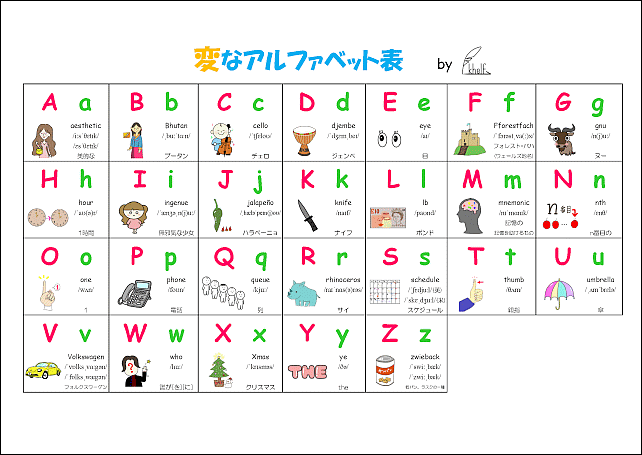
昨秋より khelf(慶應英語史フォーラム)の企画として,一般の方々にも参加していただきつつ展開してきた「変なアルファベット表」がついに完成しました.先週の3月4日,khelf より『英語史新聞』第8号が発行されましたが,その第4面に「変なアルファベット表」が掲載されています.
英語の綴字と発音の乖離 (spelling_pronunciation_gap) の問題を逆手にとって,それをダシにして遊んでしまおうという企画でした.イラスト付きアルファベット表に A から Z の各文字で始まる単語が掲げられていますが,いずれの単語も発音との関係で何かしら「変な」語頭綴字を示しています.英語初学者にとっては「意地悪な」,したがって「大人の」アルファベット表ということになります.
昨秋の本企画発足以来,khelf では担当班を組織し,主に Voicy 「英語の語源が身につくラジオ (heldio)」で進捗状況をお伝えするなど発信に努めてきました.まず,一般の方々に呼びかけて,各文字で始まる「変な」単語の候補をお寄せいただきました.その後,khelf で取りまとめた後に,各文字で始まる単語の候補のなかから,最も「変な」単語を決めていただくための投票を呼びかけました.N の単語については決選投票にまでもつれ込むことになりました.企画を進める過程で,そもそも綴字の(不)規則とは何なのかという本質的な問題にぶつかるなどしましたが,最終的には上記の通り「変なアルファベット表」が仕上がりました.各単語のイラストも khelf オリジナルの制作ですので,ぜひご注目ください.一般公募と一般投票という形で皆さんにご協力いただいた企画として,ここに完成の旨を報告し,改めて感謝申し上げます.
『英語史新聞』第8号の第4面には,「変なアルファベット表」のほか,投票結果なども掲載されています.次点候補の単語なども挙げられていますので,そちらも眺めながら綴字と発音の乖離という問題に思いを巡らせていただければと思います.
これまで「変なアルファベット表」企画に関するコンテンツを,heldio, helwa, hellog, YouTube などで様々に公開してきました.以下に一覧しておきます.特に heldio では,「変なアルファベット表」の公開後も,表に掲載されている各単語と関連する話題をお届けしています.向こう数日の配信回にもご期待ください.
・ heldio 「#872. 変なアルファベット表を作ろうと思っています --- khelf 企画」
・ heldio 「#873. スペリングの規則と反則 --- 「変なアルファベット表」企画に寄せて」
・ heldio 「#887. khelf 寺澤志帆さんと「変なアルファベット表」企画の中間報告」
・ heldio 「#924. 今週は「変なアルファベット表」のための投票週間です」
・ heldio 「#933. 「変なアルファベット表」の投票は済ませましたか? --- khelf 寺澤さんと投票の呼びかけ」
・ heldio 「#966. 「変なアルファベット表」の n- の単語のための決選投票 --- khelf 寺澤志帆さんからの呼びかけ」
・ heldio 「#1011. 「変なアルファベット表」の完成と公開 with 寺澤志帆さん」
・ heldio 「#1015. cello --- 「変なアルファベット表」からの話題」
・ heldio 「#1016. schedule の発音は「スケジュール」か「シェデュール」か? --- 「変なアルファベット表」の S の項目より」
・ helwa (有料配信) 「【英語史の輪 #42】変なアルファベット表を作る企画」
・ helwa (有料配信) 「【英語史の輪 #43】変なアルファベット表企画への反響」
・ hellog 「#5303. 『英語史新聞』第7号が発行されました」 ([2023-11-03-1])
・ hellog 「#5341. 今週は「変なアルファベット表」企画の投票週間です」 ([2023-12-11-1])
・ hellog 「#5426. 『英語史新聞』第8号が発行されました」 ([2024-03-05-1])
・ YouTube 「いのほた言語学チャンネル」 「#185. eye はもっとへんなつづりだった!!三文字規則が生み出した現象たち?---へんなアルファベット表向け単語大募集!」

2024-03-02 Sat
■ #5423. 文字によって表わされる言語学的情報はさまざまである [writing][linguistics][grammatology][orthography][spelling_reform]
表音文字は音声を表わす.表意文字は意味を表わす.表語文字は語を表わす.定義そのものを述べているだけで,当たり前のように思われるかもしれない.しかし,実際にはそれぞれの文字種は,機能的に互いに乗り入れることも多く,さまざまな言語学的情報を伝えている.
音声学の観点から文字をみると,文字は発話の流れ,音声,異音を表わすことができる.音韻論的には,文字は音節,モーラ,子音や母音の分節音,そして超分節音を表わせる.形態論的には,文字は語,屈折,派生,形態音韻論的単位に対応し得る.統語論的には,文字は構成素構造や談話構造を伝える.語用論的には,文字は強調やポライトネスを表わすこともあり得る.文字が背負い得る言語学的情報は,ほかにも考えられるだろう.
Daniels (69) は,「言語学史としての文字史」と題する論考の結論で,今後の文字論においては,文字が表わし得る言語学的情報の種類に注目することが必要であると説く.
What emerges from this survey is the unsurprising conclusion that aspects of linguistic structure that are most salient to the language user---the most accessible to conscious control: words, syllables, discourse, emphasis---are the most likely to be taken into account in their orthographies. Other features have emerged more or less incidentally over the centuries, and have either been incorporated into common usage or have dropped out of fashion. Needed is investigation of the origin and persistence of all these features in all the world's orthographies (vs the prevailing concentration on the evolution of the shapes of characters and beyond the recent attention to the acquisition of orthographies). It may show that imposition of script reform outside the context of adoption or adaptation of a script to a new language is an otiose and even futile exercise. The twin examples of Sassanian conservatism and Turkish innovation reveal that only in extraordinary circumstances can either of these extremes succeed. In every case, a writing system must be understood through the pens of those who write it.
これからの文字論のあり方に示唆を与えてくれる重要な洞察だ.
・ Daniels, Peter T. "The History of Writing as a History of Linguistics." Chapter 2 of The Oxford Handbook of the History of Linguistics. Ed. Keith Allan. Oxford: OUP, 2013. 53--69.
Powered by WinChalow1.0rc4 based on chalow